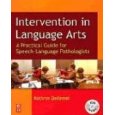Language Arts Review. Intervention in Language Arts
Language Arts review
 This book successfully demonstrates the link between oral language difficulty and reading and writing problems in school-age children.
This book successfully demonstrates the link between oral language difficulty and reading and writing problems in school-age children.
The book's great advantage is that it provides a framework and list of effective strategies for speech-language pathologists to make the most of text-based intervention.
Kathryn DeKemel outlines a range of practical diagnostic and intervention tools. The tools can be used by clinicians
to plan therapy for students with language impairment, pretty much straight away.
Intervention in Language Arts is more a practical manual, in the guise of a theoretical textbook.
Language Arts review (Too hard basket)
One of the most important sections of this book is its description of the importance of oral narratives for both assessment and intervention.
Oral narrative provides an important bridge between the
contextualized language
of home and the more difficult decontextualized language of the classroom.
Kathryn DeKemel has identified its importance, and created a very useful narrative assessment tool that can be
tailored for your individual students.
What I particularly enjoyed about this book was that Kathryn DeKemel uses real life case studies and demonstrates how
she actually uses the techniques. The examples she provides eliminates a lot of the guess work for clinicians.
My experience with new therapy techniques is that if they are difficult to plan and implement
then they tend to be thrown in the too hard basket.
Kathryn DeKemel, with this factor in mind no doubt, provides a range of assessment and therapy tools on a CD ROM that
can be implemented almost immediately with a small amount of effort.
Language Arts review (Criticisms)
One of the chief criticisms of text-based intervention is that it is not as detailed and systematic as more traditional
language intervention. Kathryn DeKemel indicates that this is simply not the case.
She does this by demonstrating that with effective goals and systematic documentation of progress, text-based intervention
is ideally suited for clinical practice. There is also a section regarding speech pathology service delivery options, including classroom based intervention.
The intervention goals contained in the text are based on research, and are considered
best practice for school-age language intervention.
Return from Language Arts review to Speech Pathology Books
Enjoy this page? Please pay it forward. Here's how...
Would you prefer to share this page with others by linking to it?
- Click on the HTML link code below.
- Copy and paste it, adding a note of your own, into your blog, a Web page, forums, a blog comment,
your Facebook account, or anywhere that someone would find this page valuable.
|